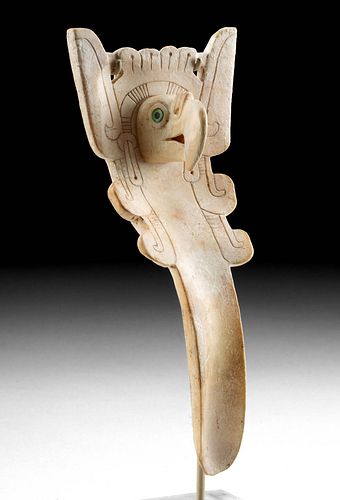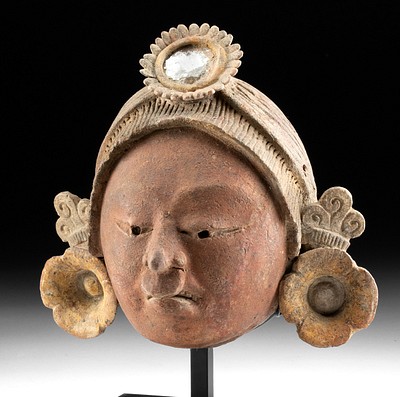Rare Aztec Shell Labret Ornament w/ Carved Eagle Head
Lot 130b
About Seller
Artemis Gallery
686 S Taylor Ave, Ste 106
Louisville, CO 80027
United States
Selling antiquities, ancient and ethnographic art online since 1993, Artemis Gallery specializes in Classical Antiquities (Egyptian, Greek, Roman, Near Eastern), Asian, Pre-Columbian, African / Tribal / Oceanographic art. Our extensive inventory includes pottery, stone, metal, wood, glass and textil...Read more
Categories
Estimate:
$13,000 - $20,000
Absentee vs Live bid
Two ways to bid:
- Leave a max absentee bid and the platform will bid on your behalf up to your maximum bid during the live auction.
- Bid live during the auction and your bids will be submitted real-time to the auctioneer.
Bid Increments
| Price | Bid Increment |
|---|---|
| $0 | $25 |
| $300 | $50 |
| $1,000 | $100 |
| $2,000 | $250 |
| $5,000 | $500 |
| $10,000 | $1,000 |
| $20,000 | $2,500 |
| $50,000 | $5,000 |
| $100,000 | $10,000 |
| $200,000 | $20,000 |
About Auction
By Artemis Gallery
Jul 14, 2022
Set Reminder
2022-07-14 10:00:00
2022-07-14 10:00:00
America/New_York
Bidsquare
Bidsquare : Exceptional Antiquities Ethnographica Fine Art
https://www.bidsquare.com/auctions/artemis-gallery/exceptional-antiquities-ethnographica-fine-art-9692
Museum-worthy examples of classical antiquities (Egyptian, Greek, Roman, Near Eastern), Viking, Far East / Asian, Pre-Columbian, African / Tribal, Oceanic, Native American, Spanish Colonial, Fossils, Ancient Jewelry, Fine / Visual Arts, so much more! Artemis Gallery info@artemisgallery.com
Museum-worthy examples of classical antiquities (Egyptian, Greek, Roman, Near Eastern), Viking, Far East / Asian, Pre-Columbian, African / Tribal, Oceanic, Native American, Spanish Colonial, Fossils, Ancient Jewelry, Fine / Visual Arts, so much more! Artemis Gallery info@artemisgallery.com
- Lot Description
Pre-Columbian, Valley of Mexico, Aztec, ca. 1200 to 1532 CE. A fascinating and rare hand carved shell ornament with a separately carved eagle head set into the upper panel. The grooved spatulate shaped tip tapers slightly and curves outward like a long tongue. The upper flared finial is incised with curvilinear motifs, earspools, and a headdress that frames the eagle head with red pigments highlighting the earspools. The eagle inserts into the drilled socket hole via a cylindrical plug and is held in place by a modern thread. The eyes are inlaid with turquoise and black stone disc beads that contrast starkly against the creamy white shell. This incredible implement may have functioned as an extravagant lip labret - the headdress top fits the contours of the lower lip, and the eagle is perfectly situated to insert into wearer's chin. The elongated spatulate tip likely represents a tongue, and the pronged top of the headdress projected upward like fangs. Size: 5" L x 2" W (12.7 cm x 5.1 cm); 5.75" H (14.6 cm) on included custom stand.
According to the Princeton University Art Museum's website: "Among the Aztec, jewelry made of precious materials marked its wearer's high social status and conveyed certain ideas about his or her character. The labret, or lip-plug, was inserted through a pierced hole in the lower lip and qualified the wearer's speech and breath as precious. The Aztec term for king, tlahtoani, means "speaker," attesting to the high value of refined, poetic rhetoric in Aztec culture. Many peoples of Mesoamerica also believed in a soul which resided in one's breath; decorating the openings in the head, including the nostrils, mouth, and ears, signaled the preciousness and vitality of a person's soul. The materials used in these ornaments came from distant lands through the Aztec's expansive trade network. Turquoise, for example, originated in modern-day New Mexico, whereas jade was procured from the border of Guatemala and Honduras."
Provenance: private Hawaii, USA collection, acquired 1995 to 2010; ex-Splendors of the World, Haiku, Hawaii, USA, before 2010; ex-Fred Bauer collection, New York City, New York, USA, 1960-2000
All items legal to buy/sell under U.S. Statute covering cultural patrimony Code 2600, CHAPTER 14, and are guaranteed to be as described or your money back.
A Certificate of Authenticity will accompany all winning bids.
PLEASE NOTE: Due to recent increases of shipments being seized by Australian & German customs (even for items with pre-UNESCO provenance), we will no longer ship most antiquities and ancient Chinese art to Australia & Germany. For categories of items that are acceptable to ship to Australia or Germany, please contact us directly or work with your local customs brokerage firm.
Display stands not described as included/custom in the item description are for photography purposes only and will not be included with the item upon shipping.
#173409Light wear and nicks to spatula groove, but overall choice and excellent. Natural shell pitting on verso and ossification. Nice remains of red pigments. Eagle head suspended from central opening via modern string.Condition
- Shipping Info
-
All shipping is handled in-house for your convenience. Your invoice from Artemis Gallery will include shipping calculation instructions. If in doubt, please inquire BEFORE bidding for estimated shipping costs for individual items.
-
- Buyer's Premium



 EUR
EUR CAD
CAD AUD
AUD GBP
GBP MXN
MXN HKD
HKD CNY
CNY MYR
MYR SEK
SEK SGD
SGD CHF
CHF THB
THB














